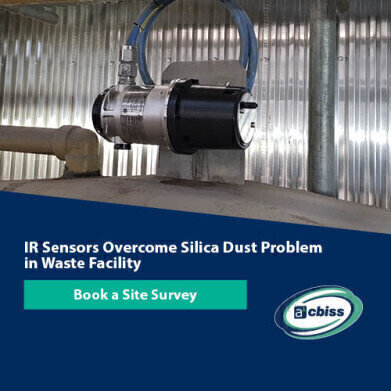Environmental Laboratory
IR Sensors Overcome Silicon Dust Problem
Aug 11 2020
A state-of-the-art Energy from Waste (EfW) facility in the North East treats enough residual waste to generate electricity to power 63,000 homes.
At the incinerator, there are four burners. The incinerator burns general household waste that can't be recycled. As a result of burning residual waste, dusty ash escapes into the atmosphere inside the plant. These dusts can contain plastics, silicones and several other possible inhibitors that could be detrimental to the life of a gas detector.
The Problem with Pellistor Sensors
There are 2 detectors on each of the 4 burners that are used to measure hydrocarbons.
Hydrocarbons are installed to measure 0-100% LEL and the risk of explosion within the facility.
When the EfW site was constructed, pellistor sensors were installed to measure hydrocarbons. A pellistor sensor is commonly used to detect combustible gases within the explosive range to warn of rising gas levels.
Once operational, the site recognised that there was a problem with the gas detectors because of low readings during a gas test. The readings were much lower than expected based on previous testing. The operations team made the decision to replace the pellistors with new sensors as a means for fixing the problem. However, after just 3 weeks the new sensors were only reading 13%LEL when using %50LEL gas - a drop of almost 75% in readings from what it should be.
Site realised they were faced with the same problem.
The site turned to a1-cbiss who were invited to conduct a site survey and identify what was going wrong.
The Site Survey
a1-cbiss carried out a thorough site survey to check the site conditions, understand the waste materials, and analyse current gas readings.
The site survey concluded and a1-cbiss believed that the issue was with the pellistor sensor technology, given the potential for silicone particles, fine dust and other potential inhibitors in the sites atmosphere”.
The problem with pellistor technology is that they're prone to poisoning from silicones commonly found in household items.
If partially coated, the sensor response is reduced significantly, however if it is fully coated, the pellistor sensor can no longer burn, and as such cannot detect any combustible gas. Inhibitors on the other hand can desensitise the sensor and shorten its life.
The IR Sensor Solution
a1-cbiss were confident that the problem would be solved by replacing the pellistor sensors with IR sensors. IR sensors can't be poisoned and provide a fast response. The biggest advantage is that IR technology provides fail-safe testing. This means that if the infrared beam was to fail, the user would be notified of this fault on the detection control panel.
The System
The GD10 Series from Oldham is so stable that an ultra fast speed of response can be achieved. The GD10 IR sensors provide unparalleled service life and detector stability, thus saving on maintenance and service costs. This is backed up with the longest combined detector and IR source warranty on the market.
Book a Site Survey to Fix Solve Your Site Issues
Digital Edition
IET 34.2 March 2024
April 2024
Gas Detection - Biogas batch fermentation system for laboratory use with automatic gas analysis in real time Water/Wastewater - Upcycling sensors for sustainable nature management - Prist...
View all digital editions
Events
Apr 24 2024 Jakarta, Indonesia
Apr 24 2024 Sao Paulo, Brasil
Apr 30 2024 Melbourne, Australia
Apr 30 2024 Birmingham, UK
May 03 2024 Seoul, South Korea


















